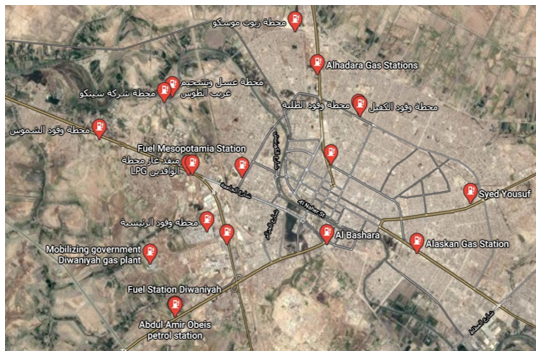Distributing and Evaluating the Locations of Petrol Stations in Diwaniyah, using Geographical Information Systems
Keywords:
petrol stations, GIS, ArcGISAbstract
The research is considered one of the researches in which the complete analyzes and results are produced by relying on GIS techniques, and it aims to analyze the distribution pattern of the stations within the boundaries of the city of Diwaniyah and compare the locations of these stations with the conditions and planning criteria for site selection, and building an information base A modernized geography of fuel filling stations that serves the concerned authorities in taking appropriate decisions related to these stations with the possibility of adding other data fields to this base for future development. We were also relying on the data obtained by the relevant authorities, such as the determinants and conditions necessary for the construction and construction of fuel stations in cities, in addition to field visits to those stations. The study assumed that the fuel stations were established without planning, and there are areas where there are no fuel filling stations, which forces the beneficiary of the service to travel a greater distance that leads to an increase in costs and an increase in the time taken to obtain the service in addition to non-compliance with safety procedures, which leads to occurrence Fire accidents and heavy loss of life and property. we found that the pattern of geographical distribution of fuel stations in the city of Diwaniyah is a sporadic pattern of distribution dispersed in the south and southeast direction and combined in the northwest direction and tilted at an angle of 34 degrees from the north to the west, and the small number of gas stations in the south and southeast sides of the city despite the density of population The high level in this region and its concentration in the northern and northwestern region, in addition to that 30% of the stations obtained a percentage of 100% appropriate to the parameters and conditions that must be met in the construction and construction of gas stations in cities and 20% of these stations got a lower percentage in the evaluation that we did in this research It was 75% a good percentage and 50% of the stations got 87.5% a good rate.
Downloads
References
Gottdiener, M. (2019). The theming of America: Dreams, visions, and commercial spaces. Routledge.
Pérez‐delHoyo, R., Mora, H., Martí‐Ciriquián, P., Pertegal‐Felices, M. L., & Mollá‐Sirvent, R. (2020). Introducing innovative technologies in higher education: An experience in using geographic information systems for the teaching‐learning process. Computer Applications in Engineering Education, 28(5), 1110-1127.
Fischer, M. M., Scholten, H. J., & Unwin, D. (2019). Geographic information systems, spatial data analysis and spatial modelling: an introduction. In Spatial analytical perspectives on GIS (pp. 3-20). Routledge.
Majeed, M. G. (2021). Analysis the Role of Housing Fund on the Construction for New Housing Case Study: Diwaniyah governorate/Iraq. Turkish Journal of Computer and Mathematics Education (TURCOMAT), 12(13), 829-838.
Abbas, M. D., Falih, A. M., & AL-Mutawki, K. G. (2020, November). A comparative study between municipal solid wastes management options in processing stage of Al-Diwaniyah city/Iraq. In Journal of Physics: Conference Series (Vol. 1664, No. 1, p. 012131). IOP Publishing.
Dakhil, A. J., Shaheed, S. M., & Alobaidi, D. A. (2019). Studying and evaluating the performance of pedestrian crossing facilities in Babil governorate. Przegląd naukowy inżynieria i kształtowanie środowiska, 28.
https://oil.gov.iq/?lang=en, last accessed 1-02-2023.

Downloads
Published
How to Cite
Issue
Section
License

This work is licensed under a Creative Commons Attribution-ShareAlike 4.0 International License.
All papers should be submitted electronically. All submitted manuscripts must be original work that is not under submission at another journal or under consideration for publication in another form, such as a monograph or chapter of a book. Authors of submitted papers are obligated not to submit their paper for publication elsewhere until an editorial decision is rendered on their submission. Further, authors of accepted papers are prohibited from publishing the results in other publications that appear before the paper is published in the Journal unless they receive approval for doing so from the Editor-In-Chief.
IJISAE open access articles are licensed under a Creative Commons Attribution-ShareAlike 4.0 International License. This license lets the audience to give appropriate credit, provide a link to the license, and indicate if changes were made and if they remix, transform, or build upon the material, they must distribute contributions under the same license as the original.





